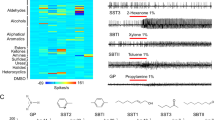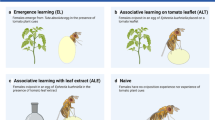Abstract
The ability of many insects to learn has been documented. However, a limited number of studies examining associative learning in medically important arthropods has been published. Investigations into the associative learning capabilities of Culex quinquefasciatus Say were conducted by adapting methods commonly used in experiments involving Hymenoptera. Male and female mosquitoes were able to learn a conditioned stimulus that consisted of an odor not normally encountered in nature (synthetic strawberry or vanilla extracts) in association with an unconditioned stimulus consisting of either a sugar (males and females) or blood (females) meal. Such information could lead to a better understanding of the ability of mosquitoes to locate and select host and food resources in nature.


Similar content being viewed by others
References
Allan SA, Bernier UR, Millikan A, Kline DL (2006) Attraction of mosquitoes to volatiles associated with blood. J Vector Ecol 31:71–78
Alonso WJ, Wyatt TD, Kelly D (2003) Are vectors able to learn about their hosts? A case study with Aedes aegypti mosquitoes. Mem Inst Oswaldo Cruz 98:665–672
Bhagavan S, Smith BH (1997) Olfactory conditioning in the honey bee, Apis mellifera: effects of odor intensity. Physiol Behav 61:107–117
Charlwood JD, Graves PM, Marshall TF de C (1988) Evidence for a ‘memorized’ home range in Anopheles farauti females from Papua New Guinea. Med Vet Entomol 2:101–108
Daly KC, Durtschi ML, Smith BH (2001) Olfactory-based discrimination learning in the moth, Manduca sexta. J Insect Physiol 47:375–384
Daly KC, Smith BH (2000) Associative olfactory learning in the moth Manduca sexta. J Exp Biol 203:2025–2038
Foster WA, Walker ED (2002) Mosquitoes (Culicidae). In: Mullen G, Durden L (eds) Medical and veterinary entomology. Academic Press New York, NY, USA, pp 203–262
Gerber B, Ullrich J (1999) No evidence for olfactory blocking in honeybee classical conditioning. J Exp Biol 202:1839–1854
Gerberg EJ, Barnard DR, Ward RA (1994) Manual for mosquito rearing and experimental techniques. American Mosquito Control Association Bulletin 5. American Mosquito Control Association, Lake Charles, LA, pp 102
Horridge GA (1997) Spatial and non-spatial coding of patterns by the honey bee. In: Srinivasan MV, Venkatesh S (eds) From living eyes to seeing machines. Oxford University Press, Oxford, UK, pp 52–79
Lewis WJ, Takasu K (1990) Use of learned odours by a parasitic wasp in accordance with host and food needs. Nature 348:635–636
McCall PJ, Kelly DW (2002) Learning and memory in disease vectors. Trends Parsitol 18:429–433
McCall PJ, Eaton G (2001) Olfactory memory in the mosquito Culex quinquefasciatus. Med Vet Entomol 15:197–203
Mwandawiro C, Boots M, Tuno N, Suwonkerd W, Takagi M (2000) Heterogeneity in the host preference of Japanese encephalitis vectors in Chiang Mai, northern Thailand. Trans R Soc Trop Med Hyg 94:238–242
Olson DM, Rains GC, Meiner T, Takasu K, Tertuliano M, Tumlinson JH, Wäckers FL, Lewis WJ (2003) Parasitic wasps learn and report diverse chemicals with unique conditionable behaviors. Chem Senses 28:545–549
SAS Institute (1998) SAS user’s guide: statistics. SAS Institute Inc. Cary, NC, USA, pp 1028
Smith BH, Getz WM (1994) Nonpheromonal olfactory processing in insects. Annu Rev Entomol 39:351–375
Smith SM, Gadawski RM (1994) Nectar feeding by the early-spring mosquito Aedes provocans. Med Vet Entomol 8:201–213
Srinivasan MV (1994) Pattern recognition in the honey bee: recent progress. J Insect Physiol 40:183–194
Takasu K, Lewis WJ (1993) Host- and food-foraging of the parasitoid Microplitis croceipes: learning and physiological state effects. Biol Control 3:70–74
Takasu K, Lewis WJ (1995) Importance of adult food sources to host searching of the larval parasitoid Microplitis croceipes. Biol Control 5:25–30
Tertuliano M, Olson DM, Rains GC, Lewis WJ (2004) Influence of handling and conditioning protocol on learning and memory of Microplitis croceipes. Entomol Exp Appl 110:165–172
Turell MJ, O’Guinn ML, Dohm DJ, Jones JW (2001) Vector competence of North American mosquitoes (Diptera: Culicidae) for West Nile Virus. J Med Entomol 38:130–134
Wäckers FL, Lewis WJ (1999) A comparison of color-, shape- and pattern learning by the hymenopteran parasitoid Microplitis croceipes. J Comp Physiol 184:387–393
Zhang SW, Bartsch K, Srinivasan MV (1996) Maze learning by honey bees. Neurobiol Learn Mem 66:267–282
Author information
Authors and Affiliations
Corresponding author
Rights and permissions
About this article
Cite this article
Tomberlin, J.K., Rains, G.C., Allan, S.A. et al. Associative learning of odor with food- or blood-meal by Culex quinquefasciatus Say (Diptera: Culicidae). Naturwissenschaften 93, 551–556 (2006). https://doi.org/10.1007/s00114-006-0143-9
Received:
Revised:
Accepted:
Published:
Issue Date:
DOI: https://doi.org/10.1007/s00114-006-0143-9




